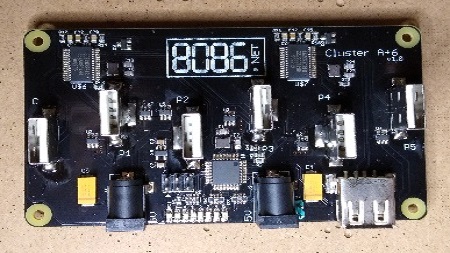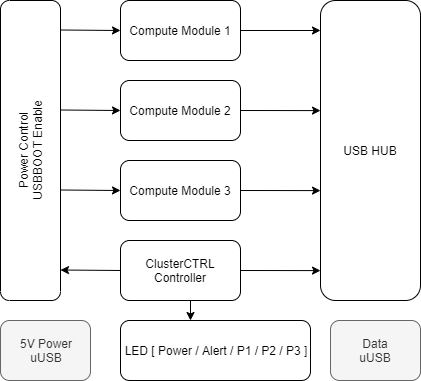
- Controller - The first of the six Raspberry Pi is the controller, the other five are P1/P2/P3/P4/P5 nodes.
- Nodes can boot either from their local SD card or via without an SD card using rpiboot as USB devices.
- Can be used with the original A+ (not A) and newer 3A+ models.
- Additional USB port is available for either USB Storage for the controller, USB Ethernet, etc.
- ClusterCTRL (I2C) USB interface allows individual control of Pi power, fan, LED, etc.
- Programmable power on states for LED, Individual Pi Power, etc.
- Unpopulated pads for ClusterCTRL UART status (for debug) and 5V fan.
- Works with the standard Cluster HAT software or you can roll your own.
- Power for both controller and nodes supplied by two 5V 2.5A supplies.
The Cluster Triple is controllerless meaning all three compute modules are nodes (none of them are the controller) so it must be used with another computer (normally a Pi) to route/bridge the USB Gadget Ethernet/Serial and control the power. This is setup automatically when using the Cluster HAT controller images (based on Raspbian) on a Raspberry Pi.
The ClusterCTRL A+6 controller uses our open source firmware(building on i2c_tiny_usb which uses V-USB) running on a Microchip ATMEGA328P/PB to provide a standard I2C interface for controlling the cluster from a controller Pi.

On the top of the ClusterCTRL A+6 there's a 2 pin header for software controlled a 5v fan.
The underside of the ClusterCTRL A+6 has an (unpopulated) UART connector (6-way SMD 0.1" pitch header) for serial debug output of the Controller (not enabled by default) and another set of pads for fans.
The 5V power voltages can also be read via the controller with clusterctrl status.
The USB controller uses the Linux i2c_tiny_usb driver, allowing the functions to be contrlled via I2C.
The following are not provided with the ClusterCTRL A+6 but are required.
- Two 5V/2.5A power supplies
- One to Three compute modules, any mix of CM1/CM3/CM3+ (Lite/4GB/8GB/16GB/32GB)
- A controller (this is normally a Raspberry Pi running the Cluster HAT controller software).